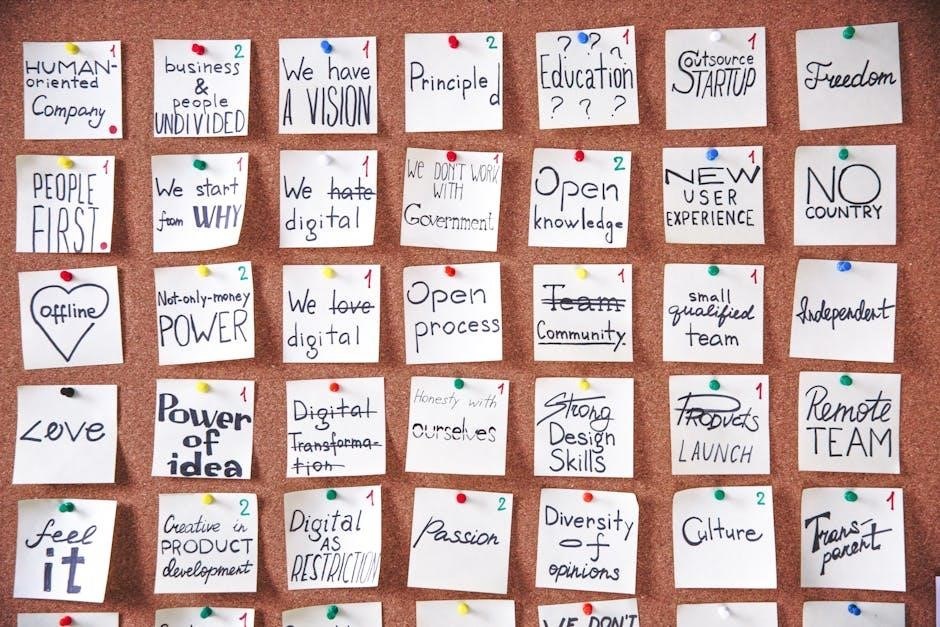The instructional design process concludes with the implementation of the training program, ensuring learning objectives are met through systematic planning and execution of educational strategies.

1.1 Definition of Instructional Design
Instructional design (ID) is the systematic process of creating educational experiences to help learners achieve specific learning objectives. It involves analyzing learning needs, designing content, and developing materials to enhance knowledge retention and skill application. Instructional designers use evidence-based strategies to ensure educational programs are effective, engaging, and aligned with desired outcomes; This field integrates psychology, education, and technology to deliver tailored learning solutions. ID is essential for creating structured and meaningful educational experiences in various settings, from classrooms to online platforms. By focusing on clear goals and learner-centered approaches, instructional design plays a vital role in transforming complex information into accessible and impactful learning opportunities.
1.2 Importance of Instructional Design in Education
Instructional design is crucial in education as it ensures learning experiences are structured, effective, and aligned with desired outcomes. It enhances knowledge retention, skill development, and overall educational efficiency. By focusing on clear objectives and learner needs, instructional design helps educators create engaging and relevant content. It also promotes the use of technology and innovative teaching methods, making learning more accessible and interactive. Instructional design caters to diverse learning styles, ensuring all students can achieve their potential. Its systematic approach minimizes gaps in understanding and improves the quality of education. Ultimately, instructional design empowers educators to deliver impactful learning experiences that prepare students for real-world challenges, making it a cornerstone of modern education.
1.3 Overview of the Instructional Design Process
The instructional design process is a structured approach to creating effective learning experiences. It begins with analysis to identify learning objectives and learner needs. The design phase follows, where content is organized, and strategies are selected. Development involves creating materials, while implementation delivers the training to learners. Finally, evaluation assesses the program’s effectiveness and identifies improvements. This systematic process ensures that educational initiatives are aligned with goals, engage learners, and achieve desired outcomes. It is iterative, allowing for continuous refinement based on feedback and results. By following these phases, instructional design ensures that learning programs are both impactful and efficient, meeting the needs of educators and learners alike in various educational settings.

Phases of the Instructional Design Process
The instructional design process concludes with the evaluation phase, assessing outcomes, gathering feedback, and determining the effectiveness of the training program to inform future improvements.
2.1 Analysis Phase
The analysis phase is the foundational step in the instructional design process, focusing on identifying learning objectives, understanding the target audience, and defining the scope of the training program. During this phase, instructional designers gather data to determine the learners’ needs, preferences, and existing knowledge levels. They also analyze the organizational goals and constraints to align the training with desired outcomes. This phase involves conducting surveys, interviews, and reviews of existing materials to inform the design strategy. The insights gained during the analysis phase guide the development of clear, measurable learning objectives and ensure the training program addresses specific performance gaps. This step is crucial for creating a tailored and effective learning experience.
2.2 Design Phase
The design phase transforms the insights gathered during the analysis into a structured blueprint for the training program. Instructional designers create detailed outlines, storyboards, and prototypes that outline the content, activities, and assessments. This phase focuses on organizing the material logically, ensuring alignment with the defined learning objectives. Designers also select appropriate delivery methods, such as e-learning modules or classroom sessions, and integrate multimedia elements like graphics, videos, and quizzes to enhance engagement. The design phase emphasizes the development of clear instructions, practice exercises, and evaluation tools to measure learner progress. By the end of this phase, a comprehensive design document is produced, guiding the subsequent development of the training program.
2.3 Development Phase
The development phase involves the creation of the actual training materials based on the design document. This is where the content is assembled, and interactive elements are built. Developers use authoring tools to create modules, simulations, and multimedia assets, ensuring alignment with the design blueprint. The focus is on producing a functional and visually appealing product that meets the learning objectives. Content is reviewed for accuracy, and testing is conducted to ensure all components work seamlessly. Feedback from stakeholders may be incorporated during this phase to refine the product further. By the end of this phase, the training materials are finalized and ready for implementation. The development phase is critical for translating the design into a tangible, learner-ready experience.
2.4 Implementation Phase
The implementation phase marks the execution of the training program, where learners engage with the developed materials. Trainers deliver the curriculum as designed, facilitating learning activities and ensuring alignment with objectives. This phase involves monitoring learner progress to identify any challenges or areas requiring adjustment. Feedback from participants is collected to gauge initial reactions and assess the effectiveness of the program. The implementation phase is crucial for ensuring that the training is delivered as intended and that learners have the opportunity to achieve the desired outcomes. It also sets the stage for the evaluation phase, where the overall success of the program will be measured. Proper execution during this phase is essential for achieving the intended learning results.
2.5 Evaluation Phase
The instructional design process concludes with the evaluation phase, which assesses the effectiveness of the training program. This phase involves measuring whether the learning objectives were met and identifying areas for improvement. Evaluation can be divided into two categories: formative and summative. Formative evaluation provides feedback during the design process, while summative evaluation occurs at the end to measure the overall impact. Data collection methods include surveys, quizzes, and performance metrics to gauge learner outcomes and satisfaction. The results from this phase are used to refine the program, ensuring it aligns with organizational goals and learner needs. Effective evaluation ensures the training program delivers measurable results, justifying its development and implementation. This phase is critical for continuous improvement and long-term success.

The Conclusion of the Instructional Design Process
The instructional design process concludes with the final review of objectives, delivery of the program, and assessment of outcomes. This ensures quality and alignment with organizational goals.

3.1 Final Review of Learning Objectives
The instructional design process concludes with a thorough final review of learning objectives to ensure they align with the desired outcomes. This step involves evaluating whether the objectives are clear, measurable, and achievable. It also includes verifying that the content and activities developed during the design process effectively support these objectives. Stakeholders and subject matter experts are often involved to validate the relevance and accuracy of the objectives. Any gaps or inconsistencies identified during this review are addressed to ensure the program meets its intended goals. This final check is essential for guaranteeing the quality and effectiveness of the training program before its delivery.
3.2 Delivery of the Training Program
The instructional design process concludes with the delivery of the training program, ensuring learners engage with the content effectively. This phase involves selecting the appropriate delivery method, such as in-person sessions, e-learning modules, or hybrid approaches, based on the audience’s needs and preferences. The program is then executed, with facilitators guiding learners through activities and materials developed during the design process. Accessibility is a key consideration, ensuring all learners can participate fully. Feedback mechanisms are often integrated to monitor engagement and understanding in real time. Successful delivery is critical for achieving the intended learning outcomes and preparing learners to apply their newfound knowledge and skills effectively.
3.3 Assessment of Learning Outcomes
The instructional design process concludes with the assessment of learning outcomes, ensuring that learners have achieved the desired knowledge, skills, and behaviors. This phase involves evaluating the effectiveness of the training program through various methods, such as quizzes, assignments, and performance tasks. The assessment aligns with the learning objectives established during the design phase, providing insights into the learners’ understanding and application of the content. Data collected during this phase helps determine whether the program has met its goals and identifies areas where improvement may be needed. Ultimately, the assessment phase ensures that the training program delivers measurable results and prepares learners to apply their knowledge in real-world scenarios.
3.4 Evaluation of the Training Program’s Effectiveness
The instructional design process concludes with the evaluation of the training program’s effectiveness, ensuring it meets its intended goals and delivers value to learners. This phase involves collecting feedback from participants, instructors, and stakeholders to gauge satisfaction and identify strengths and weaknesses. Key performance indicators, such as completion rates and post-training assessments, are analyzed to measure impact. The evaluation also compares the program’s outcomes against its objectives and industry standards. By examining both qualitative and quantitative data, the effectiveness of the training is determined, providing insights for future improvements. This step ensures the program remains relevant, engaging, and aligned with organizational or educational goals, fostering continuous enhancement and better learning experiences.
3.5 Documentation of Results
The instructional design process concludes with the documentation of results, a critical step for accountability and future reference. This involves compiling and organizing data collected during the evaluation phase, such as learner outcomes, feedback, and program performance metrics. The documentation includes detailed reports, summaries, and visual representations like graphs or dashboards to illustrate key findings. This process ensures transparency and provides stakeholders with a clear understanding of the program’s impact. The documented results also serve as a foundation for decision-making, helping to identify areas for improvement and informing the design of future training initiatives. By maintaining a comprehensive record, the instructional design process demonstrates its value and supports ongoing refinement and compliance with educational standards.

Implementation of the Training Program
The instructional design process concludes with the execution of the training program, delivering the curriculum, facilitating learning activities, and monitoring learner progress to ensure successful outcomes.
4.1 Execution of the Designed Curriculum
The execution of the designed curriculum marks the final stage of the instructional design process, where the meticulously planned content is delivered to learners. This phase involves the systematic rollout of instructional materials, ensuring alignment with predefined learning objectives. Instructors or facilitators play a crucial role in presenting the content, whether through lectures, group activities, or e-learning modules. The curriculum is implemented in a structured manner, adhering to the sequence and pacing outlined during the design phase. Additionally, this stage includes the deployment of assessments and evaluations to measure learner progress. The execution phase also requires continuous monitoring to address any challenges and ensure the curriculum is delivered as intended, setting the stage for successful learning outcomes and subsequent evaluation.
4.2 Facilitation of Learning Activities
Facilitation of learning activities is a critical component of the instructional design process, ensuring that learners engage actively with the content. This phase involves creating an environment that fosters participation, collaboration, and interaction. Facilitators guide discussions, encourage questioning, and promote hands-on experiences to deepen understanding. Learning activities are tailored to diverse learning styles, incorporating strategies such as group work, simulations, and problem-solving exercises. The goal is to ensure that learners not only absorb information but also apply it in practical contexts. Effective facilitation requires strong communication skills, adaptability, and the ability to address individual needs while maintaining alignment with the curriculum’s objectives. This step is essential for maximizing learner engagement and achieving desired educational outcomes.
4.3 Monitoring Learner Progress
Monitoring learner progress is a vital step in the instructional design process, ensuring that learners are on track to meet the defined objectives. This involves regularly assessing performance through quizzes, assignments, and observational checks. Facilitators use data to identify areas where learners may need additional support or resources. Progress tracking helps maintain engagement and motivation, as learners receive timely feedback and guidance. Tools such as learning management systems (LMS) and progress dashboards are often utilized to streamline this process. By continuously monitoring progress, facilitators can adjust their strategies to better meet learner needs, ultimately enhancing the overall effectiveness of the training program. This step is crucial for ensuring successful learning outcomes and preparing learners for the final assessment phase.

4.4 Addressing Learner Feedback
Addressing learner feedback is essential for refining the training program and ensuring it meets learner needs. Feedback is collected through surveys, discussions, or one-on-one interactions, providing insights into strengths and areas for improvement. Instructors review this feedback to identify common challenges or misconceptions and adjust teaching strategies accordingly. This iterative process fosters a more engaging and effective learning environment. By actively responding to feedback, facilitators demonstrate a commitment to learner success, enhancing overall satisfaction and outcomes. This step ensures the training program remains relevant and impactful, aligning with learner expectations and organizational goals. Addressing feedback is a critical component of continuous improvement in instructional design.

Evaluation of Training Results
The instructional design process concludes with the evaluation of training results, ensuring the program meets its objectives and aligns with learner and organizational goals effectively.
5.1 Measurement of Knowledge Retention
Measuring knowledge retention is a critical step in evaluating the effectiveness of a training program. This process involves assessing how well learners have retained the information and concepts presented during the training. Various methods, such as quizzes, tests, and practical exercises, are used to gauge retention levels. These assessments are typically conducted at the end of the program and sometimes at intervals after completion to measure long-term retention. The data collected helps instructional designers understand whether the learning objectives were met and identify areas where learners may need additional support. By analyzing retention rates, organizations can refine their training content and delivery methods to enhance future programs. Effective measurement ensures that the training achieves its intended learning outcomes and supports continuous improvement in instructional design.

5.2 Assessment of Skill Application
Assessing skill application evaluates how effectively learners can apply the knowledge and skills acquired during training to real-world scenarios. This step goes beyond knowledge retention, focusing on practical implementation. Techniques such as hands-on projects, simulations, and workplace observations are commonly used. Feedback from facilitators and peers provides insights into learners’ ability to perform tasks successfully. This assessment helps identify whether the training has equipped learners with the necessary competencies to meet organizational goals. By evaluating skill application, instructional designers can determine the program’s practical impact and make adjustments to improve future training initiatives. This step ensures that learners are not only knowledgeable but also capable of applying their skills effectively in their roles.
5.3 Analysis of Learner Satisfaction
The instructional design process concludes with the analysis of learner satisfaction, which measures how well the training program met learners’ expectations and needs. This step involves collecting feedback through surveys, interviews, or focus groups to gauge learners’ perceptions of the content, delivery, and overall experience. The analysis helps identify strengths and areas for improvement, ensuring the program is engaging and relevant. High satisfaction levels often correlate with increased engagement and better learning outcomes. By evaluating learner feedback, instructional designers can refine the program to better align with learner preferences and organizational objectives. This step ensures that the training not only imparts knowledge but also fosters a positive learning experience, enhancing overall effectiveness and future program design.
5.4 Identification of Areas for Improvement
The instructional design process concludes with the identification of areas for improvement, ensuring the training program remains effective and aligned with its objectives. This step involves analyzing data collected during the evaluation phase, such as learner performance, feedback, and outcomes. By pinpointing weaknesses or gaps in the program, instructional designers can address specific issues, such as unclear content, ineffective delivery methods, or outdated materials. This iterative process allows for targeted revisions, enhancing the overall quality and impact of the training. Continuous improvement ensures the program evolves to meet changing learner needs and organizational goals, fostering a more dynamic and adaptive instructional design approach.

Continuous Improvement in Instructional Design
The instructional design process concludes with the commitment to continuous improvement, ensuring the training program evolves to meet learner needs and organizational goals effectively.
6.1 Iterative Refinement of the Training Program
The instructional design process concludes with the iterative refinement of the training program, ensuring it remains relevant and effective. This phase involves revisiting and updating the curriculum based on feedback from learners, instructors, and stakeholders. Data collected during the evaluation phase is analyzed to identify areas requiring improvement. Continuous adjustments are made to content, delivery methods, and assessments to enhance learning outcomes. This iterative approach fosters a culture of ongoing improvement, ensuring the program adapts to changing needs and emerging trends. By refining the training program regularly, instructional designers can ensure it remains aligned with organizational goals and delivers measurable results. Iterative refinement is a critical step in maintaining the program’s effectiveness and relevance over time.
6.2 Incorporation of Feedback into Future Designs
The instructional design process concludes with the incorporation of feedback into future designs, ensuring continuous improvement. Feedback from learners, instructors, and stakeholders is systematically collected and analyzed to identify strengths and weaknesses. This information is then used to refine content, improve delivery methods, and enhance overall learning experiences. By integrating feedback, instructional designers can address gaps, clarify confusing concepts, and align the program more closely with learner needs. This step ensures that the training program evolves over time, remaining relevant and effective. Incorporating feedback fosters a learner-centered approach and demonstrates a commitment to quality and adaptability in instructional design. It also lays the groundwork for future iterations of the program.
6.3 Alignment with Emerging Educational Trends
The instructional design process concludes with the alignment with emerging educational trends, ensuring the program remains relevant and innovative. As education evolves, instructional designers must adapt to new technologies, teaching methods, and learner preferences. Trends such as microlearning, gamification, and AI-driven personalization are integrated to enhance engagement and accessibility. By staying attuned to these developments, designers create modern, flexible learning experiences that cater to diverse needs. This alignment not only improves the effectiveness of the training but also prepares learners for future challenges. Regular updates and modernization ensure the program stays current, fostering a dynamic and adaptive learning environment that meets the demands of a rapidly changing world.